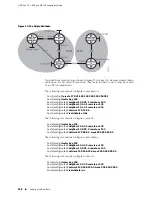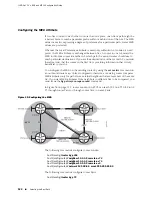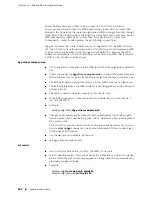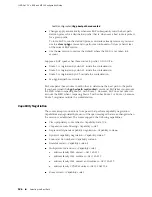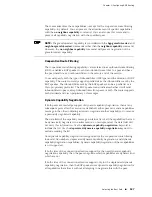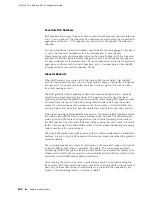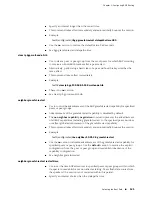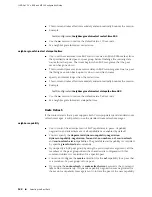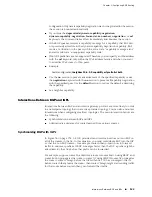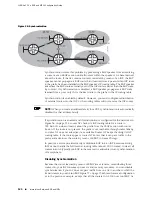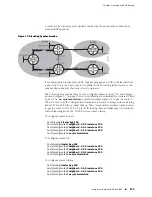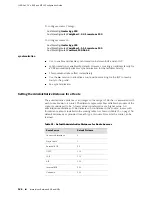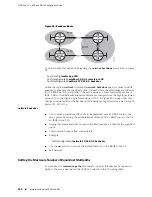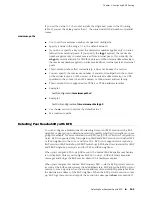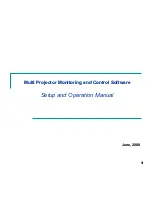
The router advertises these capabilities—except for the cooperative route filtering
capability—by default. You can prevent the advertisement of specific capabilities
with the
no neighbor capability
command. You can also use this command to
prevent all capability negotiation with the specified peer.
NOTE:
The graceful restart capability is controlled with the
bgp graceful-restar
t and
neighbor graceful-restart
commands rather than the
neighbor capability
command.
However, the
no neighbor capability
command will prevent negotiation of the
graceful restart capability.
Cooperative Route Filtering
The cooperative route filtering capability—also referred to as outbound route filtering
(ORF)—enables a BGP speaker to send an inbound route filter to a peer and have
the peer install it as an outbound filter on the remote end of the session.
You must specify both the type of inbound filter (ORF type) and the direction of ORF
capability. The router currently supports prefix-lists as the inbound filter sent by the
BGP speaker. The inbound filter sent by the BGP speaker can be a prefix list or a
Cisco proprietary prefix list. The BGP speaker must indicate whether it will send
inbound filters to peers, accept inbound filters from peers, or both. The router supports
both standard and Cisco-proprietary orf messages.
Dynamic Capability Negotiation
If both peers acknowledge support of dynamic capability negotiation, then at any
subsequent point after the session is established, either peer can send a capabilities
message to the other indicating a desire to negotiate another capability or to remove
a previously negotiated capability.
The data field of the capability message contains a list of all the capabilities that can
be dynamically negotiated. In earlier versions, now deprecated, the data field did
not carry this information. Use the
dynamic-capability-negotiation
keyword to
include the list. Use the
deprecated-dynamic-capability-negotiation
keyword to
exclude sending the list.
Nondynamic capability negotiation is supported for the cooperative route filtering,
four-octet AS numbers, deprecated dynamic capability negotiation, and dynamic
capability negotiation capabilities. Dynamic capability negotiation of these capabilities
is not supported.
If both sides of the connection advertise support for the new dynamic capability
negotiation capability, then the peers negotiate which capabilities are dynamic and
which are not.
If both sides of the connection advertise support only for the deprecated dynamic
capability negotiation, then the BGP speaker uses dynamic capability negotiation for
all capabilities that allow it without attempting to negotiate this with the peer.
Selecting the Best Path
■
127
Chapter 1: Configuring BGP Routing
Summary of Contents for BGP
Page 6: ...vi ...
Page 8: ...viii JUNOSe 11 1 x BGP and MPLS Configuration Guide ...
Page 37: ...Part 1 Border Gateway Protocol Configuring BGP Routing on page 3 Border Gateway Protocol 1 ...
Page 38: ...2 Border Gateway Protocol JUNOSe 11 1 x BGP and MPLS Configuration Guide ...
Page 234: ...198 Monitoring BGP JUNOSe 11 1 x BGP and MPLS Configuration Guide ...
Page 236: ...200 Multiprotocol Layer Switching JUNOSe 11 1 x BGP and MPLS Configuration Guide ...
Page 542: ...506 Monitoring BGP MPLS VPNs JUNOSe 11 1 x BGP and MPLS Configuration Guide ...
Page 544: ...508 Layer 2 Services Over MPLS JUNOSe 11 1 x BGP and MPLS Configuration Guide ...
Page 610: ...574 Virtual Private LAN Service JUNOSe 11 1 x BGP and MPLS Configuration Guide ...
Page 624: ...588 VPLS References JUNOSe 11 1 x BGP and MPLS Configuration Guide ...
Page 680: ...644 Virtual Private Wire Service JUNOSe 11 1 x BGP and MPLS Configuration Guide ...
Page 724: ...688 Monitoring MPLS Forwarding Table for VPWS JUNOSe 11 1 x BGP and MPLS Configuration Guide ...
Page 725: ...Part 6 Index Index on page 691 Index 689 ...
Page 726: ...690 Index JUNOSe 11 1 x BGP and MPLS Configuration Guide ...






